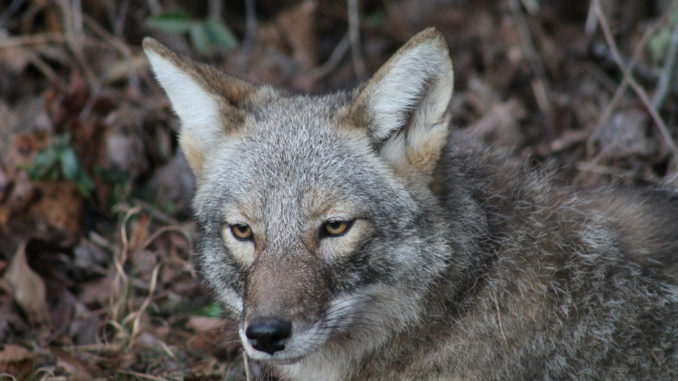
This Denton hunter has filled in the gap between hunting seasons and helped preserve his deer herd by targeting coyotes.
Coyotes do more than howl. Along with their usual diet of small game — and anything edible that gets under their noses — these cagey predators can do some damage to a deer herd.
Deer-density maps compiled by the N.C. Wildlife Resources Commission show that North Carolina’s Piedmont, in particular the Uwharrie mountains, are loaded with whitetails, but these days, deer hunters have four-legged competition. They share the old, round-topped mountains with coyote packs that howl deep into the night.
Predation of young deer is reason enough to shoot coyotes in the Uwharries. Quite a few hunters spot and shoot coyotes from their stands during deer season, but instead of howling about problems with these varmints, James Ash of Denton has taken coyote hunting to a new level. For him, predator hunting is a pleasant pursuit that is worthy of his time and effort.
“I like to hunt coyotes because they are the smartest thing in the woods — besides me, “he said. “That is all I do after deer season.”
Ash quickly learned that the local canines are a lot smarter than Wile E. Coyote. The famous cartoon character spent decades without success chasing his nemesis, the Roadrunner, across television screens, despite all of his traps and schemes that kept the fictional ACME company in business.
Ash said he’s killed 12 to 15 coyotes annually for the past seven years; coyote hunting has become a thrilling sport for him in its own right. To meet the challenge, he has trained himself to be adept with camouflage and stalking techniques plus a selection of calls and decoys.
Any successful hunt begins with proper scouting, and Ash devotes a lot of time studying local coyote packs. To improve the odds, he has invested in the latest gear and learned how to use it, but he still comes home empty-handed on occasion. Over the years, he has learned that coyotes run in packs of four or five, each covering a range of less than a mile, eating any creature they can catch — as some deer hunters have learned, the hard way.
Coyotes will help themselves to wounded deer that hunters lose in the woods; in these part, hunters must find the downed animals quickly. If they wait too long, coyotes will find the deer first, and they leave little behind except scraps, bones and maybe a few tracks.
Ash has preached to other hunters that thinning out coyotes will protect the local deer herd.
“Coyotes have their pups in late February,” he said. “About April, the deer fawns will start moving and coyotes get a lot of them.”
Not if Ash gets them first. He uses a mouth call to mimic a coyote howl to locate the animals. If done correctly, a mouth call will provoke a response from a nearby predator, but that’s only part of the job. Once located, hunters must use the wind correctly or they will never get a shot.
“Most of the time, coyotes will answer back,” he said. “When that happens, they circle downwind from your position.”
Of course, like any skilled hunter, Ash makes very effort to control his human scent. Skilled hunters know to avoid perfumed soaps for their bodies and clothing. He uses scent-control clothing and other products to keep his scent to a minimum. All of that is helpful, but Ash knows he has to work the wind. The best way is to keep the wind in your face if possible.
“Once a coyote smells you, it is gone,” he said.
Once he hears back from his prey, Ash switches to a mouth call or an electronic caller to mimic the squeal of an injured rabbit. A moving decoy that looks like a rabbit struggling in the brush completes the illusion. For coyote sniping, Ash wears a Ghillie suit — the kind invented by old-time Scottish gamekeepers and put to good use by military snipers on battlegrounds around the world.
Ash shoots his Ruger .204 varmint rifle from a sitting position. The .204 is a flat-shooting cartridge that rockets a 30- or 40-grain bullet downrange at more than 4,000 feet per second out to 500 yards — more than enough power to drop a wily coyote with a single shot. To even the odds a little more, Ash uses a bipod and 4×20 power scope.
Ash sells guns and ammo at Sports Country, a popular hunting/fishing store in Denton. The store puts on a coyote-hunting contest that ends the last day of March. Last year, other hunters entered six coyotes, but Ash led the back with a 35-pound female he shot on Jan. 24, 2012.
“That was a big coyote for a female,” he said.
Ash took that coyote on private land in Randolph County. Not far from US 64, he set up on a ridge that overlooked a draw leading to a creek and wound up making a 150-yard shot.
Local hunters look to Ash for advice on taking out the varmints. First, coyote hunters must learn to respect their quarry.
“I hunt whitetails and wild turkeys,” Ash said. “To me, a coyote is the hardest thing in the woods to kill.”
Perry Sumner, a biologist for the N.C. Wildlife Resources Commission, has tracked the progress of coyotes across the state since the 1980s, when hunters and farmers first noticed them in greater numbers. Sumner has travelled across the state teaching sportsmen’s groups and others the best way to deal with coyotes. Forget the cartoon images of Wile E. Coyote losing out to the Roadrunner. Sumner summed it up at a meeting with outdoor writers in Asheboro, another Uwharrie Mountain town where coyotes prowl.
“The dumbest coyote is smarter than the most-intelligent dog,” Sumner said.
When coyotes move in, they get rid of the local foxes that compete for food and prey. It is widely believed that certain fox hunters brought coyotes to North Carolina because they provided more sport for their hounds. One story in particular credits the escape of coyotes from a large fox-hunting pen with populating much of the state. They also may have spread into North Carolina from states on its western border.
It doesn’t matter how they arrived, because they are here to say, according to Sumner. For centuries, humans have tried all sorts of things — including poison and traps — to wipe out coyotes, and to no avail. Today the predators are more common than ever, and North Carolina offers them plenty of food.
Across the state, landowners, farmers and pet owners have complain about coyotes killing domesticated animals. Hunters have been able to legally shoot the animals as varmints since the early 1990s, and last year, the Commission took it a step further, passing on July 19 a temporary rule, good for 270 days, allowing hunters to shoot coyotes (and feral hogs) at night with the aid of lights, but only on private land with owner consent. Also, bow hunters can shoot them on Sundays on private land.
Speakers at public hearings around the state have expressed concern with the change, fearing that it will lead to an increase in spotlight-poaching of deer, but coyote hunters can’t ride roads with spotlights glaring.
Last November, the Eastern band of the Cherokees placed a $25 bounty for each coyote shot and turned in; trapped animals don’t qualify for the bounty. The tribe is trying to restore the deer herd to the reservation, and coyotes threaten that effort. Robert Blankenship, who manages tribal fisheries and wildlife, was quoted that coyotes are the main predators of whitetail fawns.
“Our goal is to thin them out, and hopefully, increase the fawn survival rate,” he said.
Concerns over shooting of red wolves — which look a lot like coyotes — in five eastern counties around the Alligator National Wildlife Refuge, brought about a court order to close night hunting in those counties after several red wolves were shot, presumably mistaken for coyotes.
The Uwharries are not part of the red wolf zone, but they are the site of a successful wildlife restoration effort. In the late 1940s, the late Ollie Thompson, a game warden, led an effort to restock whitetail deer to the area known as the Uwharrie Reservation before it became a national forest. Deer were trapped in the mountains and moved to the Uwharries, and the herd subsequently spread all over the Piedmont and beyond.
No one wants coyotes to deplete the Uwharries’ deer herd, and sportsmen are starting to pitch in. Tony Sullins, who owns of Sports Country in Denton, is meeting the demand for new varmint hunters.
“We are selling a lot of lights,” said Sullins, who believes coyote hunting not only protects the deer herd, it fills in a void in the outdoor schedule. “This gives hunters something to do between deer and turkey season.”
Deer hunters are not the only ones concerned with coyote depredation. Local farmers worry about losing livestock to coyotes.
Curtis Redding, a Randoph County farmer, knew he had at least one coyote prowling his farm near Sophia. One day, he saw the coyote in a pasture that contained several calves. Born ready, he had a rifle in his pickup truck and took out the predator.
“That coyote could have taken a calf,” he said.
Farmers can keep donkeys, dogs and llamas in their pastures to help keep coyotes away, but those options aren’t available to city dwellers, who have spotted them on the prowl, often preying on pets, even inside city limits.

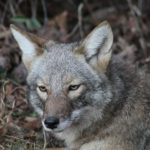
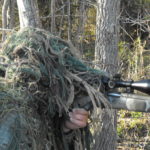
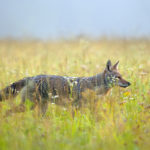
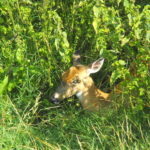
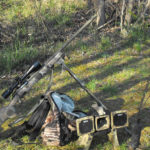


Be the first to comment